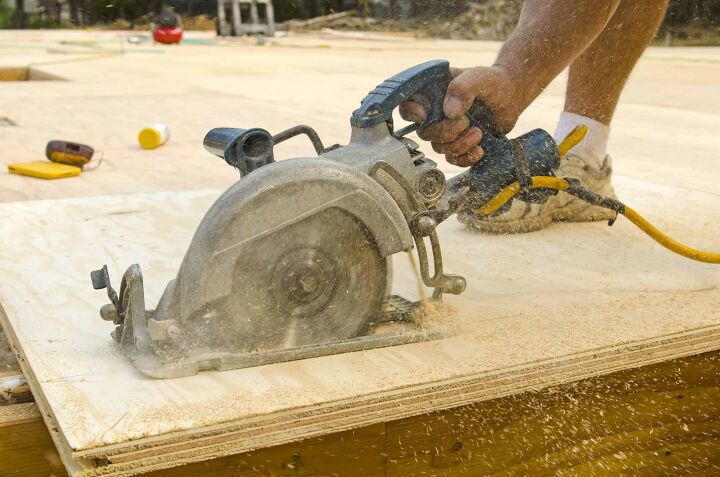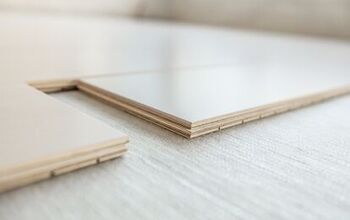Can You Use A Router to Cut Plywood?

Routers are highly functional tools that every DIYer should consider adding to their arsenal. They’re typically used in woodcutting but have a variety of additional applications.
If you own a router, you may be curious to know the extent of what you can do with it. One of the most common questions asked is whether routers can be used to cut plywood.
Yes, you can use a router to cut plywood. However, you will need to purchase the correct bits for the task. Additionally, your results may vary based on the type of wood you cut. To cut plywood you will want a spiral up-cut, solid tungsten carbide cutter bit, which is the best for this job.
Don't want to do it yourself?
Get free, zero-commitment quotes from pro contractors near you.

What is a Router?
If you’ve never used a router before, you may be curious about what they are and how they work. Put simply, a router is a hand or power tool that hollows out (routs) an area in hard material. They’re most commonly used on woods and plastics.
The original router was a hand tool that was equipped with a narrow blade. Today, routers can also be power tools. These are usually driven by an electric motor.
How Do You Use a Router?
Routing is a shaping process. It’s a process that’s most commonly used to create finished edges and more defined shapes. However, you can also use routers to create cuts, holes, and contours in various materials.
Using a router isn’t very difficult. However, you will need to purchase a router bit (also called a cutting tool) to do so. Some routers also require guide templates while others can be attached to a table for added control.
The specific way that you operate your router will vary based on the characteristics of the model that you purchase. Be sure to consult with your owner’s manual before powering your router on for the first time.
What Kinds of Router Bits Are Available?
Routers have grown in popularity in recent years because of how many different tasks they can complete. This is, in large part, thanks to the variety of router bits that DIYers can purchase. These allow routers to accomplish more varied tasks.
There are many different types of router bits that you may wish to purchase. The most common is called a straight router bit. These are used to make cuts straight down into a material like wood or plastic. They range in size from 3/16-inch to 1-1/2-inch.
Another commonly used router bit is called a rabbeting router bit. These produce a cut that can be both straight vertical and horizontal. They’re best suited for creating notches in the edges of a material like wood or plastic.
Other options include edge forming router bits, molding router bits, and raised panel bits. Each will help you refine the materials that you’re working with in different ways.
What Router Bit is Best for Plywood?
In order to cut plywood with a router, you’re going to want to first equip your tool with the right bit. DIYers have several options to choose from here.
One of the most commonly recommended router bits for cutting plywood is a spiral up-cut, solid tungsten carbide cutter. These bits are capable of cutting about 800 linear feet flawlessly with 3/4-inch penetration.
That being said, up-cut bits aren’t perfect. When used on plywood, some DIYers have reported excessive surface tear. This means that the edges of your cut may not be as uniform as you would like for them to be.
Another option to consider is a straight bit solid tungsten carbide cutter. These bits can help you create a more uniform cut throughout the top, middle, and bottom of your plywood. It could be a better option if you plan to use the plywood in a piece of furniture or another item that will be displayed.
How to Cut Plywood with a Router
Cutting plywood with a router isn’t difficult in and of itself. However, the task can be challenging for DIYers who haven’t worked much with a router in the past. If you belong to that group, then follow the step-by-step guide below to cut plywood with your router.
Step 1: Before Starting
The first thing you need to do is to loosen the router’s collet. Do this by turning the collet nut in an anti-clockwise direction. Once you’ve done that, you can insert the router bit that you want to use and re-tighten the nut to secure it.
Be sure not to over-tighten the nut here. Doing so could make the cutting process more difficult. Once you’ve finished this, you may want to perform a quick test cut on a piece of plywood to ensure everything is functioning properly.
Step 2: Secure the Plywood
Cutting through plywood will become a difficult task if you haven’t secured the wood before starting. The best way to do this is with a workbench.
You can also use a router mat, which will give you an excellent non-skid surface to work on. Mats also allow you to work around all four edges of plywood without issue.
Step 3: Protect Yourself
When cutting wood, it’s always important to keep yourself protected. You haven’t accomplished this until your eyes, ears, and hands are protected.
This means that you should put on safety glasses, earplugs, and gloves before getting started with your project. Securing the plywood to a workbench is another part of keeping yourself safe while cutting with a router.
Step 4: Begin Cutting
It’s important to take your time while working with a router. As you perform cuts, you should hold your router firmly and move it from left to right across the plywood. This ensures that wood is being cut along the grain, which makes the process effortless and smooth.
You should also use shallow cuts when working with plywood. If you try to make deep cuts immediately, you risk splintering the wood. Shallow cuts also give you more control over the work, allowing for greater precision.
DIYers can also reduce wood splintering by choosing the right bits. Router bits that are sharp and high-quality can make a big difference in the effectiveness of your cuts. With that in mind, it’s a good idea to invest in a good router bit if you plan on doing this type of work often.
Finally, it’s important that you adjust the router bit speed to match the size of the bit. Bits that have larger diameters need to be used at a slower speed. Doing this can help to prevent tear-our, which is another problem that could impact the quality of your plywood cuts.
Don't want to do it yourself?
Get free, zero-commitment quotes from pro contractors near you.

Do I need a fixed-base or plunge-base router?
Fixed-base routers allow you to position the router in a constant position. Plunge-base routers allow you to preset the cut depth and lower the bit into the wood as needed.
If you plan on just doing a few home improvement projects with a router, then a plunge-base is usually the better option. It gives you more flexibility than fixed-base routers do.
How much do routers cost?New routers can be purchased from popular home improvement stores like the Home Depot for as little as $50. However, to get a quality tool, you should look to invest anywhere between $100 and $250.

Kellan is a content writer who specializes in everything DIY. When he's not behind the keyboard, he enjoys spending time with his pets, playing music, and geeking out about basketball. He hopes to make your home improvement projects a little bit easier to accomplish.
More by Kellan Jansen



























